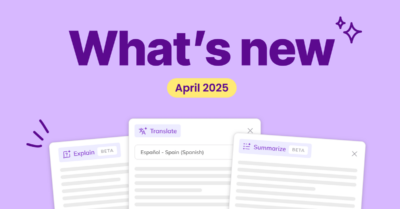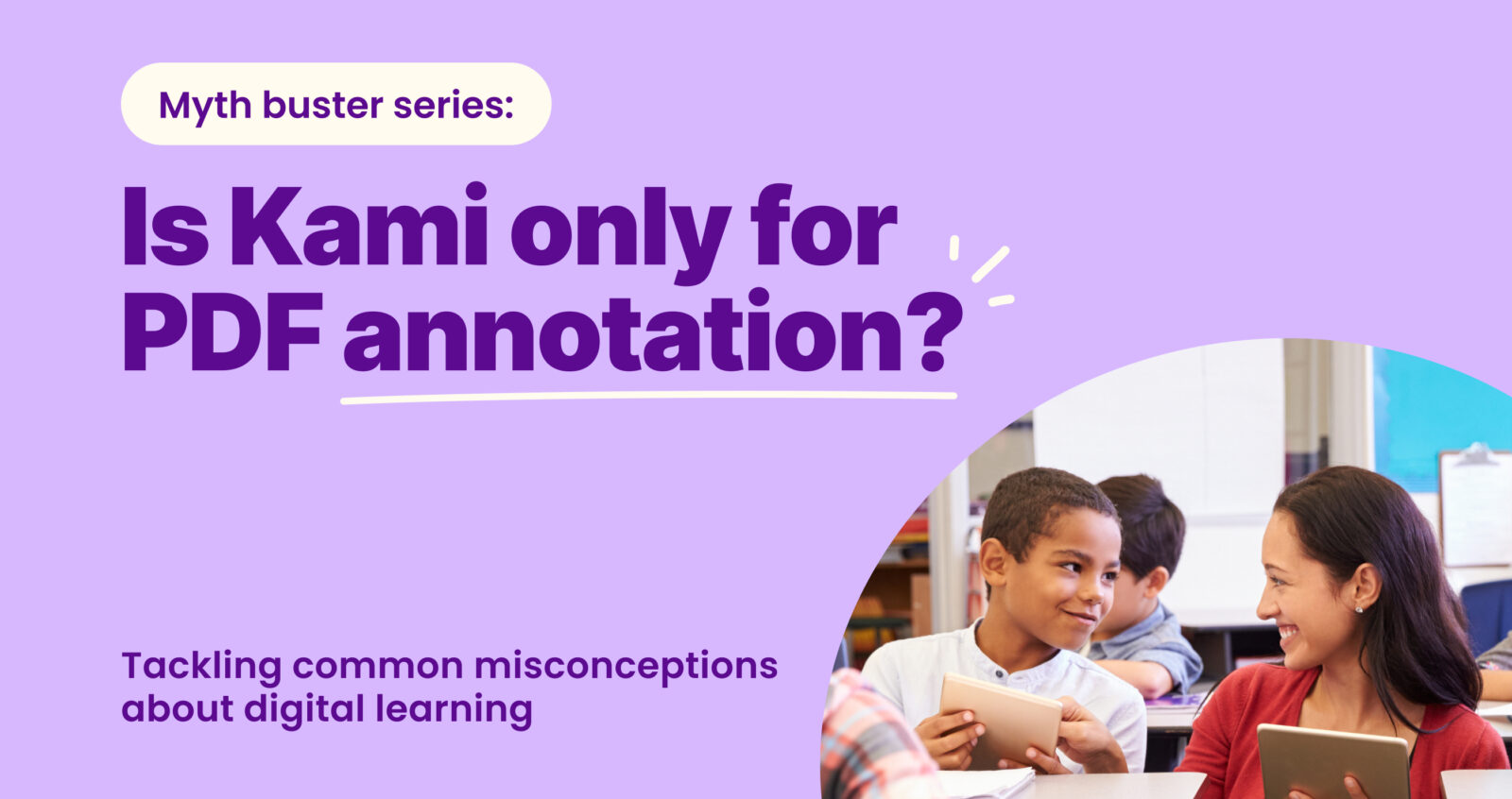Shirin Bradfield
Welcome to the first edition of our ‘Myth Buster’ series – where we challenge common misconceptions in education technology. Today’s myth: Is Kami just a PDF annotation tool?
We get it. Kami did start out that way. But the platform has evolved dramatically to meet the complex and ever-changing demands of today’s classrooms. With teachers expected to engage students, differentiate instruction, support learners with IEPs and ELL needs, and manage time-consuming administrative tasks, simple annotation doesn’t even scratch the surface.
In this Q&A, Paul Savage (a.k.a “Savvy”), Senior Product Marketing Manager at Kami, sits down with Nanz Nair, Product Designer, to unpack what Kami really offers beyond annotations.
Savvy:
Nanz, let’s start with the elephant in the room. Why is it a myth that Kami is just a PDF annotation tool?
Nanz:
That’s a great kickoff, Paul. While Kami began as a PDF annotation tool, it has evolved into a full instructional platform designed to address the complex and diverse needs of today’s classrooms. Early on, PDF annotation was critical—especially during the COVID-19 pandemic when millions of teachers suddenly found themselves teaching remotely. In that moment, Kami became an essential tool for educators who needed to quickly annotate PDF worksheets, lessons, and documents to maintain continuity in their teaching.
We saw a huge influx of users – over 20 million during the COVID surge – where PDF annotation was one of the immediate needs for remote learning. But over time, as the demands of education evolved, so did Kami. It’s a platform that enables real-time collaboration, provides students with interactive multimedia tools, includes AI-powered formative assessments, autograding and real-time insights, and offers accessibility features like text-to-speech, read-aloud, and voice typing.
Savvy:
That’s right, and it’s increasingly considered an indispensable tool for Special Education (SPED), isn’t it?
Nanz:
Indeed. We’ve introduced features that specifically support students with diverse learning needs, such as those with IEPs, and we are continually building on these capabilities. Our commitment to scaffolding tools has led us to develop solutions that help SPED teachers create the least restrictive, stigma free environment for their students.
Teachers can embed videos, insert audio feedback, assign tasks, and scaffold learning using tools like text-to-speech and read-aloud. Students respond with text, voice, drawing, or video. So, what started as a mark-up tool, has evolved into meaningful interaction and differentiated instruction—all within the same platform.
In essence, Kami is where content comes alive.
Savvy:
You mentioned accessibility. How does Kami ensure every student has an equitable learning experience?
Nanz:
Tools like Read Aloud, Voice Typing, Closed Captions, Dictionary, and Feature Control are built to support all learners – especially those with IEPs, 504 plans, personalized learning plans, or ELL needs.
For instance, students with dyslexia can listen to text, while others can dictate their responses using voice typing. English Language Learners can use the Translate feature, hear the content in their home language, or engage with multimedia supports to understand the material.
And coming soon is Kami Companion – our next-gen accessibility toolkit. It brings comprehension support like screen masking, simplified text, and predictive text directly to students, wherever they’re learning – on PDFs, websites, or assignments. Companion ensures support doesn’t end with the document. It goes wherever the student goes.
Savvy:
Ok, let’s talk about differentiation. How does Kami help teachers tailor learning to individual students or groups?
Nanz:
Kami’s flexibility makes differentiation seamless. With Class View, teachers can monitor student progress in real-time and make on-the-fly updates—without needing to recreate or reassign tasks.
They can personalize feedback with text boxes, audio, or video comments, and assign alternative tasks based on ability level or learning preference. Even better, they can use Split & Merge to prepare resources in minutes by combining curriculum materials, assessments, and accommodations into a single learning flow.
Savvy:
We know that time pressure is a constant factor for educators. How does Kami actually help teachers win time back?
Nanz:
Kami’s time-saving impact is real. Our users report saving an average of 8 hours per week.
Teachers can automate grading with AI-powered assessments, use auto-grading to instantly evaluate responses, and even generate standards-aligned questions directly from existing class materials.
Kami also integrates tightly with the popular learning management systems like Google Classroom, so there’s no need to jump from app to app. Everything—from differentiating resources and assigning work to grading and feedback—happens in one place. That’s a huge win for educators juggling a million tasks.
Savvy:
And how does Kami support formative assessment and real-time feedback?
Nanz:
Teachers can use our new tool Questions AI to create formative assessments directly from curriculum resources or any supplemental material. It’s then really easy to add personalised touches and send these out to the class. Students simply fill out their answers and return – they can also use Kami’s annotation tools to show working directly on the assessment.
Kami makes feedback instant and actionable. During lessons, teachers can watch student work unfold in Class View and jump in with real-time comments or help.
They can also use Insights to spot patterns—like students who need more support or concepts the class is collectively struggling with. The Answers View provides a question-by-question breakdown, so teachers don’t need to guess where students are falling behind.
It’s formative assessment with clarity and powered by AI. It’s changing the way teachers teach.
Savvy:
Engagement is always top-of-mind. How does Kami make learning more interactive and fun?
Nanz:
Kami is built to empower student voice and choice. Whether it’s annotating a poem with highlights, recording an audio reflection, or responding to a prompt through video, students choose how they express themselves.
This flexibility boosts creativity and ownership. It also helps teachers see deeper into student understanding—not just if they got it right, but how they got there.
Plus, group assignments with real-time collaboration build teamwork and social learning skills. Kami brings the whole classroom together—even when students are apart.
Savvy:
And what about schools and districts focused on IEP compliance or serving multilingual learners?
Nanz:
We genuinely believe that Kami is a game-changer for SPED and ELL classrooms. Our tools help meet accommodation requirements under IDEA for students with disabilities and Title III for English Language Learners.Teachers can customize the accessibility tools available to students, scaffold instruction as needed, and monitor student progress directly within Kami.
Soon, Kami Companion will go even further. It’s designed to offer comprehension aids across websites, curriculum sites and digital materials—not just PDFs. So whether a student needs help simplifying an english passage to a more ability appropriate grade or lexile level or understanding a science article online, Kami Companion will be right there with them wherever they do their learning.
This ensures equitable learning at scale—providing consistent support regardless of where or how students are learning.
Savvy:
So, Nanz, to wrap up—what’s the biggest takeaway here? What’s the truth behind the “just a PDF tool” myth?
Nanz:
The truth is, Kami is redefining what it means to teach and learn digitally. It’s an all-in-one platform that saves teachers time, engages students, supports IEPs, 504 plans and ELL learners, and delivers real classroom insights.
If I had to sum it up in just a few words, I’d say that it’s not just annotation—it’s transformation.
Summary
The idea that Kami is only a PDF annotation tool couldn’t be further from the truth. From accessibility to AI, differentiation to data, Kami empowers teachers and students with the tools they need to succeed in today’s classrooms.
Whether you’re looking to streamline workflows, personalize learning, or support diverse learners, Kami goes beyond the document to transform instruction and elevate outcomes for all.
Discover more
To learn how Kami can support your classroom, school, or district, speak to our team today:
👉 Connect with the Kami Sales Team
You may also like

One platform, every learner: How Fond du Lac School District transformed digital learning with Kami

Unlocking understanding: Kami’s latest updates designed for every learner

